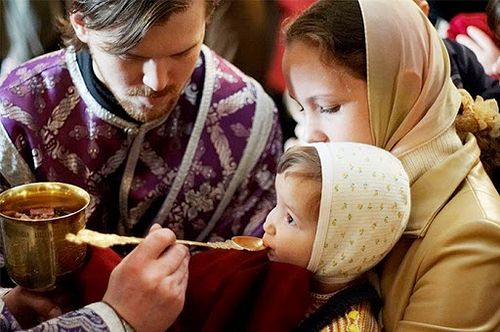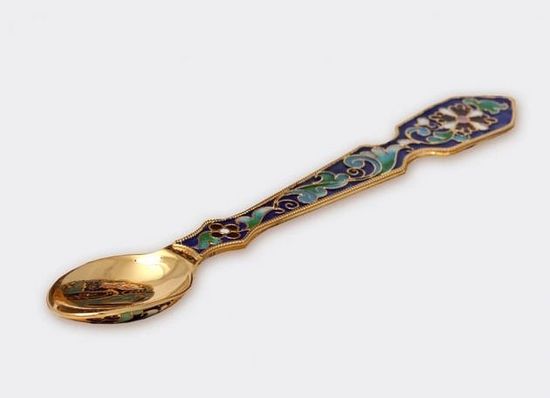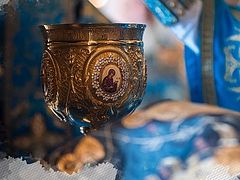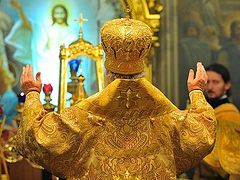The Communion Spoon is a symbol of union between God and man, in as much as this is possible. That is to say, receiving the Body and Blood of Christ is real Divine Communion—Communion with God. The Communion of the Holy Mysteries of Christ is the closest most intimate communion of man with God. And the Spoon is a symbol of this communion.
In the Greek tradition, it is called the Κοχλιάριον (Kochliárion), Λαβίδα (Lavitha) or λαβή/λαβις (Lavi(s), in Latin, it is called the Cochlear, and in Slavonic, the Лжи́ца, (Lzhítza). [The Greek Lavis can refer to tongs, i.e. the sort you would pick up a hot live coal from a fire with—Trans.]
Here is a reference to the Holy Scriptures of the Old Testament, namely, the Book of the Prophet Isaiah:
In the year that king Uzziah died I saw also the Lord sitting upon a throne, high and lifted up, and his train filled the temple. Above it stood the seraphims: each one had six wings; with twain he covered his face, and with twain he covered his feet, and with twain he did fly. And one cried unto another, and said, Holy, holy, holy, is the Lord of hosts: the whole earth is full of his glory. And the posts of the door moved at the voice of him that cried, and the house was filled with smoke. Then said I, Woe is me! for I am undone; because I am a man of unclean lips, and I dwell in the midst of a people of unclean lips: for mine eyes have seen the King, the Lord of hosts. Then flew one of the seraphims unto me, having a live coal in his hand, which he had taken with the tongs from off the altar: And he laid it upon my mouth, and said, Lo, this hath touched thy lips; and thine iniquity is taken away, and thy sin purged (Isaiah 6:1-7).
But why does the spoon in liturgical tradition, symbolize the tongs of the holy Seraphim, with which he touched the lips of the prophet Isaiah, cleansing him of sin? The fact is, that in ancient times, the laity communed in the same way as the clergy. The priest’s right hand placed a piece of the Body of Christ in their hands, and then, after its consumption, believers partook of the Chalice of Christ’s Blood. During this moment, the clergyman’s hand is truly reminiscent and symbolic of the tongs. And he himself symbolized the messenger of God—the Seraphim, through whose actions man is cleansed of sin and united with God.
But such a method of communing the laity did not take root in the Church, for the reason that sometimes people, having unseemly intentions, took parts of the Body of Christ home to perform sacrilege over them, or simply did not handle them properly.
The first to introduce spoons for communion was St. John Chrysostom. In his life, we read that this great teacher of the Church introduced this innovation after a woman took a particle of the Body of Christ home for witchcraft. Upon learning about this, the Holy Hierarch ordered all the churches to use special spoons for Communion, to lay the Body of Christ, immersed in the Blood of Christ, directly into the mouths of the faithful, cutting off all sorts of temptations and opportunities for sacrilege and desecrating the Holy of Holies. Such a tradition has taken root in other Churches.
Some sources claim that the spoon was introduced into liturgical use during times later than those in which St. John Chrysostom lived. But the reason for its introduction into the service, it seems to me, is clear from the above example, from the life of St. John Chrysostom.
Also, the spoon symbolizes the Church, which teaches us of the necessity for spiritual divine sustenance in our lives.
Together with Holy Chalice, it also symbolizes that all of us Orthodox Christians, partake of the life-giving Sacraments of Christ from one source, and that we are one in Christ.
Therefore, it is always a sad sight for a priest to see, when a Christian sets about approaching the Chalice with disgust, with a thought like: “People are licking that spoon. It’s gross". Such a person does not quite understand why he came to communion in the first place, and what he is about to do. He does not understand that the Body and Blood of Christ is the holiest thing in the Orthodox Church. This is a heavenly fire, in which all bacteria and germs burn, and our sins as well.
And we must approach this Most Holy Gift with the fear of God and faith. We should long for it as the main guarantee of our salvation, and not think about how many people have touched a spoon with their lips. The main thing is that you touched it, that these Divine tongs with the hot live coal of the Divine Mysteries have cleaned you. The Lord enters into you. He burns your sins and makes you a temple of His Holiness. You must reverently, with love and fear, receive Him, like a beloved Father. Like a person suffering from a painful disease receives the long-awaited doctor.
No one has ever become ill from receiving the sacraments of the Church, but millions have been healed, recovered, and saved.
This is what you must meditate on. Let us recall the words of the Holy and All-Lauded Apostle Paul:
For I have received of the Lord that which also I delivered unto you, that the Lord Jesus the same night in which he was betrayed took bread: And when he had given thanks, he brake it, and said, Take, eat: this is my body, which is broken for you: this do in remembrance of me. After the same manner also he took the cup, when he had supped, saying, this cup is the new testament in my blood: this do ye, as oft as ye drink it, in remembrance of me. For as often as ye eat this bread, and drink this cup, ye do shew the Lord's death till he come. Wherefore whosoever shall eat this bread, and drink this cup of the Lord, unworthily, shall be guilty of the body and blood of the Lord. But let a man examine himself, and so let him eat of that bread, and drink of that cup. For he that eateth and drinketh unworthily, eateth and drinketh damnation to himself, not discerning the Lord's body. For this cause many are weak and sickly among you, and many sleep. For if we would judge ourselves, we should not be judged. But when we are judged, we are chastened of the Lord, that we should not be condemned with the world (1 Cor. 11:23-32).
We must understand, that we can partake unto ourselves for healing and salvation, but also unto judgement and condemnation. One can take communion unto health, or through sacrilegious excuses, (including a sense of disgust), unto illness. One can take communion unto life, but one can also take communion unto death. Judas also communed at the Last Supper. And after the sacrament, satan entered him, pushing that man to commit the most evil deed in history. After all, Judas did not partake with the desire to unite with God, but with a desire to betray Him.
And the main prerequisite in the sacrament is the fear of God, love and faith in the Lord, a passionate desire to be with Him, to unite with Him, to live with Him. Such a man in front of the Chalice, like a chick, opens his mouth to his parent, is letting God into the spiritual temple of his body, who, as a loving Father, leads his child to salvation.
Let us trust God, dear brothers and sisters, and the thoughts of Judas—vile and disgusting—we must drive away from us.
A loving God is waiting for each of us; and each of us is called unto His saving Chalice.
Approach with the fear of God, with faith and love draw near!






